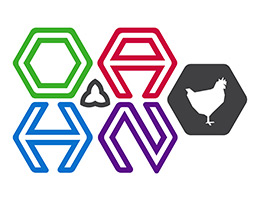Ontario Animal Health Network (OAHN)
Poultry Expert Network
Quarterly Producer Report
Not just for the birds: Prevent Highly Pathogenic Avian Influenza (HPAI) from spreading between cattle and poultry facilities
Dr. Emily Martin (AHL)
Highly pathogenic A/Goose/Guangdong/1/1996 (GsGD) A(H5N1) influenza viruses were first identified in Southern China in 1996. Since then, the virus has expanded geographically and caused multiple disease outbreaks in poultry. Due to reassortment, viruses from the GsGD H5-lineage have evolved into phylogenetically distinct hemagglutinin (HA) clades, with clade 2.3.4.4b viruses having quickly expanded geographically since its incursion into North America in late 2020. (1)

Outbreaks of H5N1 have occurred in waves over time and geographic expansion of affected areas, specifically in mammals, is shown in Figure 1.
Since 2020, H5N1 has not only expanded geographically but also expanded to infect numerous mammalian species.

Since March 2024, dairy cattle have been detected with H5N1 in the United States. There are currently no H5N1 positive dairy cattle detected in Canada (July 2024).
Multiple resources to monitor this ongoing situation in the US can be found here:
- AVMA (American Veterinary Medical Association: Avian influenza type A (H5N1) in U.S. dairy cattle webpage.) https://www.avma.org/resources-tools/animal-health-and-welfare/animal-health/avian-influenza/avian-influenza-virus-type-h5n1-us-dairy-cattle. The AVMA provides a good overview of the current situation in the USA and recommendations.
- CDC: Avian Influenza (Bird Flu) webpage https://www.cdc.gov/bird-flu/situation-summary/mammals.html
Information on the current H5N1 bird flu situation in dairy cattle including number of cases, number of affected states, and information on monitoring for H5 in people. - CFIA: Highly pathogenic avian influenza (HPAI) in cattle webpage https://inspection.canada.ca/en/animal-health/terrestrial-animals/diseases/reportable/avian-influenza/latest-bird-flu-situation/hpia-livestockThis page provides links for producers (how to prevent spread), consumers (what you need to know), veterinarians (guidance on clinical signs and sampling). There is also information on milk sampling and testing, as well as trade implications.
The cases in US dairy cattle have shown the ability to transmit to poultry facilities due to shared personnel or equipment. Dairy farmers and poultry producers should examine potential links between these 2 types of production facilities and either eliminate or implement risk management measures.
References:
1.Kandeil A, Patton C, Jones JC, et al. Rapid evolution of A(H5N1) influenza viruses after intercontinental spread to North America. Nat Commun. 2023;14:3082. https://doi.org/10.1038/s41467-023-38415-7
2.Plaza PI, Gamarra-Toledo V, Euguí J, Lambertucci SA. Recent Changes in Patterns of Mammal Infection with Highly Pathogenic Avian Influenza A(H5N1) Virus Worldwide. Emerg Infect Dis. 2024;30(3):444-452. https://doi.org/10.3201/eid3003.231098
Poultry Veterinarian Survey Highlights – Q1 2024 (Dec 2023 – Feb 2024)
Broilers
Practitioners
Stable conditions:
Early systemic bacterial infection (< 14 days old), other causes of mortality (> 14 days old), late systemic bacterial infection (> 14 days old), lameness bacterial/developmental and nutritional, ascites, coccidiosis, infectious bursal disease (IBDV), condemnation issues and Salmonella.
Stable to increased conditions:
Runting Stunting Syndrome (RSS) and Inclusion body hepatitis (IBH).
Stable to decreased conditions:
Lameness viral and infectious bronchitis (IBV).
Equally stable, increased, or decreased conditions:
Spiking mortality.
Frequency of conditions seen in the flocks:
Common: Early and late systemic bacterial infection, IBH and Infectious bronchitis.
Common or rare: Other causes of mortality and ascites.
Rare: Lameness viral and bacterial, IBVD.
Rare to not seen: Lameness developmental and nutritional, coccidiosis, necrotic enteritis (NE), spiking mortality and RSS.
AHL
Similar number of cases (from previous quarter):
- Other causes of mortality (> 14 days old, mycotic pneumonia).
- Lameness developmental (tibial dyschondroplasia).
- Coccidiosis (Small intestine, both small intestine and ceca).
- Inclusion body hepatitis (FAdV08b_AHL_16-049095_ON, FAdV08b_AHL_18-057921_ON, and FAdV11_USA_1047).
- RSS – Suspect.
Increased number of cases (from previous quarter):
- Late systemic bacterial infection (> 14 days old) – All cases had at least E. coli isolated either in pure culture or in combination with E. cecorum, P. aeruginosa, or G. anatis and Salmonella Enteritidis.
- Lameness bacterial (Primarily diagnosed on histology. Also, osteomyelitis and E. coli.).
- Lameness viral (Reovirus confirmed: SK_R12, ON_variant_H_18-008168 and Pennsylvania 13-095523).
- Ascites.
- Necrotic enteritis.
- Infectious bursal disease (PCR positive field strains: USA PA105-2014, USA 66-Indiana-2014, British Columbia 15-062782, and USA Del-E. Vaccine strains: USA W2512-Blen, and UK Faragher 52-70.).
- RSS – Confirmed.
Decreased number of cases (from previous quarter):
- Early systemic bacterial infection (< 14 days old) – All cases had at least E. coli isolated either in pure culture or in combination with E. cecorum, P. aeruginosa, or Salmonella sp.
- Lameness viral (Reovirus suspicious).
- Infectious bursal disease (pathology cases).
- Infectious bronchitis (IBV – pathology cases and PCR positive) (Field strains: IBV_DMV_ON_21-017385 and IBV_DMV_ON_15-077145. Vaccine strains: IBV_Conn, USA Mass-AHL 21-008165, and IBV_Mass-MA5.)
No cases diagnosed this quarter:
- Lameness nutritional (rickets).
- Spiking mortality.
- Dead on arrival (DOA).
- Condemnation issues.
Other diagnostic findings:
Histomoniasis, spiking mortality, fibrinoheterophilic pneumonia, airsacculitis, typhlitis, dermatitis, and cellulitis.
Salmonella:
Practitioners: The most common serotypes isolated were serotypes B and D with S. Heidelberg listed with the clinical impression. Laboratory reports with detection of subtypes of S. Enteritidis, S. Kentucky and S. Alachua (graph below).
Animal Health Laboratory Salmonella Isolations: Broilers
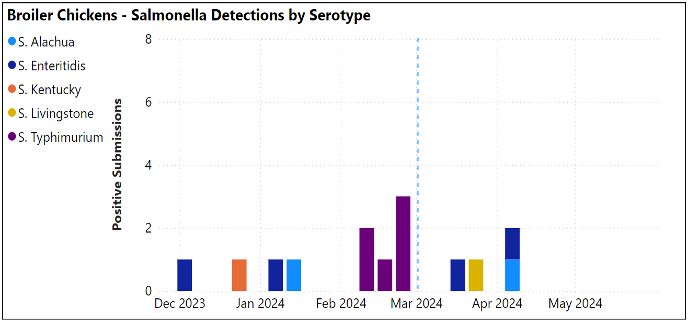
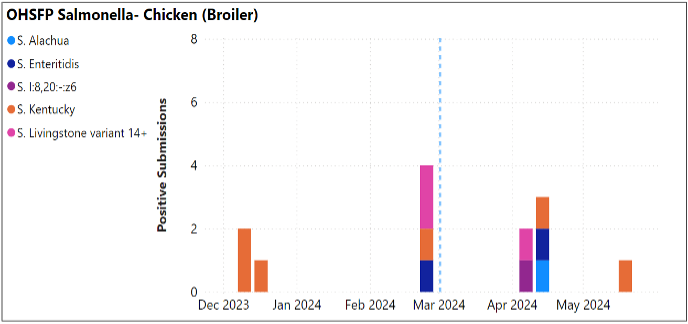
Condemnation conditions in provincial slaughter plants:
The top carcass postmortem condemnation conditions reported for March-May 2024 were ascites, airsacculitis, and cellulitis.
Comparison of provincial condemnation conditions:
Jan-May 2023 vs. Jan-May 2024
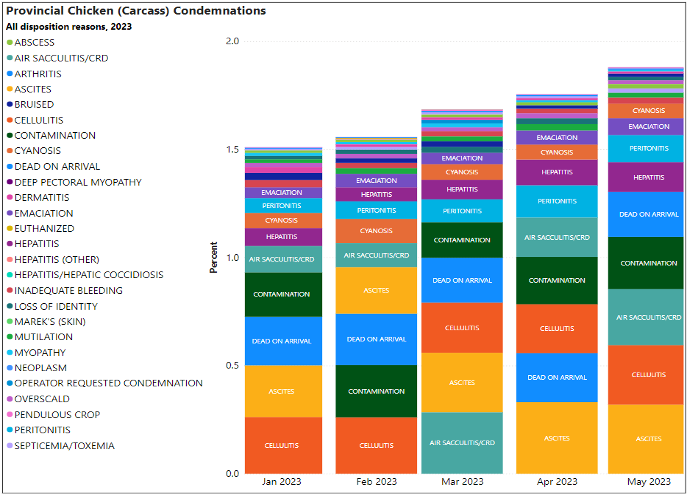
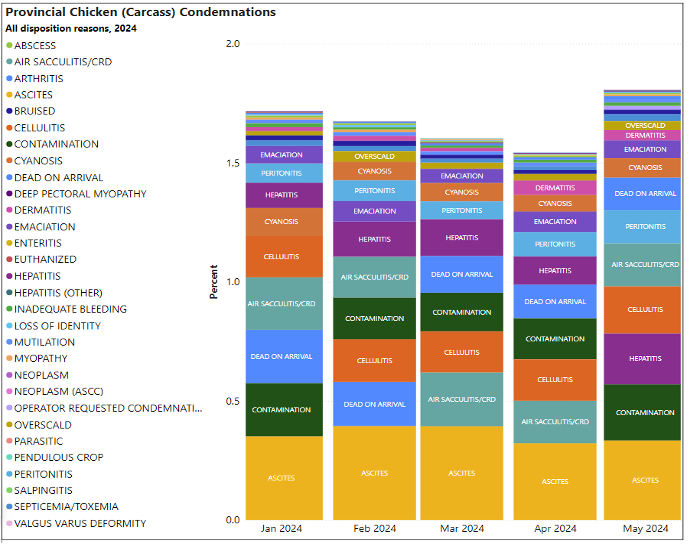
Number of chickens slaughtered, Jan-Jul 2024.
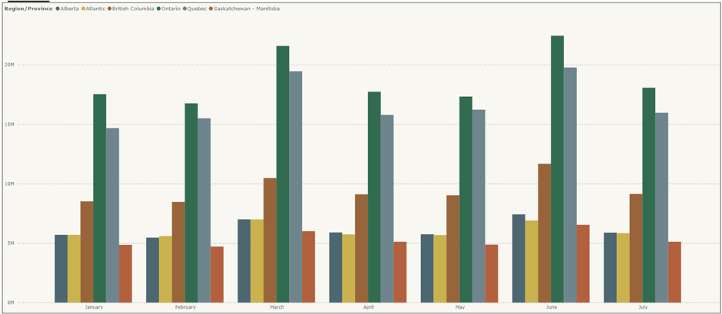
Subcutaneous conditions, abdominal edema, and respiratory conditions were reported as the main postmortem condemnation conditions for chickens slaughtered in federally inspected plants in Ontario for Jan-Jun 2024 (graph below).
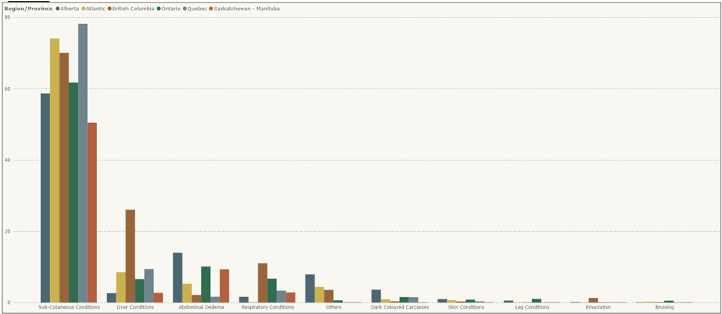
Broiler-Breeders
Practitioners
Stable conditions:
Fowl cholera, other causes of early mortality, lameness viral/developmental/nutritional, inlay bacterial septicemia (E. coli), disease hatchability issues, necrotic enteritis, coccidiosis, fowl pox, ILT and multi-drug-resistant E. coli.
Stable to increased conditions:
Early bacterial infection (<14 days) and histomoniasis.
Stable to decreased conditions:
Lameness bacterial (mixed infections with E. coli, E. cecorum and Staphylococcus aureus), IBV (decreased productivity/abnormal eggs/sudden spike in mortality), mycoplasmosis, aggression and cannibalism.
Frequency of conditions seen in the flocks:
Common: Avian metapneumovirus infection and bacterial lameness.
Common to rare: Inlay bacterial septicemia and disease related hatchability.
Common to not seen: Early bacterial infection.
Common, rare or not seen: Coccidiosis, aggression and cannibalism.
Rare or not seen: Fowl cholera, other causes of early mortality, IBV (decreased production/abnormal eggs/sudden spike in mortality), necrotic enteritis, multi-drug-resistant E. coli and histomoniasis.
Not seen: Mycoplasmosis, fowl pox, ILT, lameness viral/developmental/ nutritional.
AHL
Fowl cholera (Pasteurella multocida) – Occasionally isolated from lameness cases from vaccinated flocks.
New conditions: Avian metapneumovirus (aMPV).
- Sinusitis: All cases had at least E. coli isolated either in pure culture or in combination with S. aureus, E. cecorum, or G. anatis. Also E. coli, E. cecorum and G. anatis combined.
- Otitis: E. coli and S. hyicus. Also E. coli and E. cecorum isolated together as well as with G. anatis, or Avibacterium spp.
Similar number of cases (from previous quarter):
- Early bacterial infection (<14 d old) – Cases had either E. coli or S. aureus isolated in pure culture or in combination.
- Other causes of mortality (> 14 days old, encephalitis).
- Bacterial pneumonia – All cases had at least E. coli isolated either in pure culture or in combination with S. aureus, E. cecorum, or G. anatis. In addition, E. coli, E. cecorum and G. anatis combined.
- Lameness bacterial – S. aureus was isolated in pure culture or in combination with E. coli, and P. multocida. E. coli and E. cecorum were isolated together or in combination with S. aureus and P. multocida. E. coli isolated either in pure culture or in combination with P. aeruginosa. In addition, S. aureus, E. cecorum and P. multocida combined. A case of osteomyelitis had E. coli, E. cecorum and S. aureus isolated.
- Lameness nutritional (rickets).
- IBV (decreased productivity/abnormal eggs/sudden spike in mortality) – (IBV_DMV_ON_21-017385, CU82792, and IBV_Mass-MA5 vaccine).
- White Chick Syndrome.
Increased number of cases (from previous quarter):
- Inlay bacterial septicemia – Most cases had E. coli isolated in combination with E. cecorum, S. aureus, or G. anatis. E. coli and E. cecorum were isolated together along with S. aureus, G. anatis, Avibacterium spp., or G. anatis and S. aureus. S. aureus was also isolated in pure culture.
- Cellulitis/Dermatitis – E. coli or S. aureus isolated in pure culture or in combination. E. coli and E. cecorum were isolated together as well as with S. aureus.
- Trauma (bone fracture).
- Pododermatitis (E. cecorum).
- Necrotic enteritis.
Decreased number of cases (from previous quarter):
- Prelay morbidity/mortality (<20 weeks) – Cases had either E. coli or S. aureus isolated in pure culture or in combination with E. cecorum. Also, E. coli with Bacillus cereus. Other prelay diagnoses included mycotic pneumonia (Aspergillus) and intussusception.
- Coccidiosis – Identified in the small intestines (1 E. necatrix), ceca, or both the small intestines and ceca.
- Intestinal parasitism – Histomonas, Ascaridia, and Heterakis.
No cases diagnosed this quarter:
- Lameness viral – Reovirus.
- Lameness developmental.
- Fowl pox.
- ILT and Mycoplasmosis.
Other diagnostic findings:
Gangrenous dermatitis (E. coli, P. aeruginosa and Clostridium sp.), conjunctivitis/uveitis, cannibalism, emaciation, salpingitis (E. coli, E. coli and E. cecorum isolated together or with P. aeruginosa), liver hemorrhage, subcutaneous hemorrhage (head, crop), sinusitis, necrotizing glossitis (caustic), enteritis (E. coli), typhlitis, ascites/heart failure, dehydration, urate nephrosis/visceral urates and amyloidosis.
Animal Health Laboratory Salmonella Isolations in Broiler Breeders (see graph bellow):
- There were No positive submissions outside of OHSFP (Ontario Hatchery and Supply Flock Program).
- Environmental samples – boot/environmental/peptone swabs, fewer positive submissions and serotypes isolated in the spring compared to winter months.
- Two excess mortality submissions where Salmonella was isolated with no further information available.
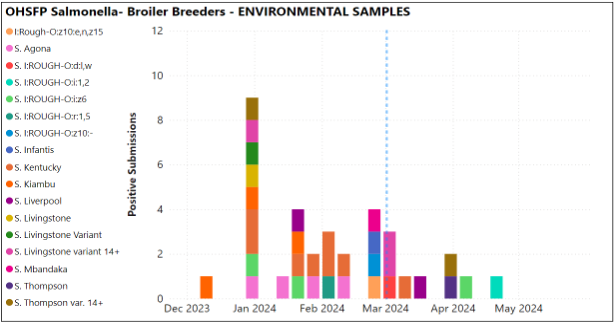
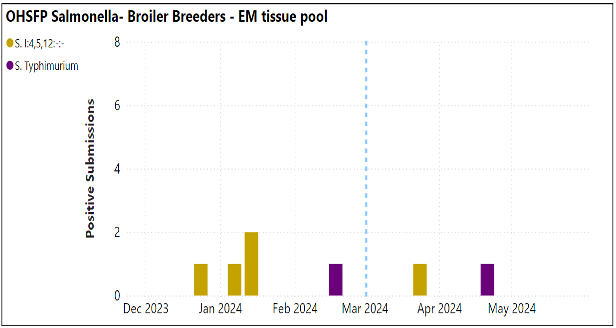
Layers
Practitioners
The same as last quarter, veterinarians reported good, stable and solid health status for the past 3 months.
Stable conditions:
Osteoporosis, bacterial peritonitis/salpingitis, early systemic bacterial infection, other causes of early mortality, focal duodenal necrosis (FDN), ILT, mycoplasmosis (M. gallisepticum), coccidiosis, necrotic enteritis, aggression, cannibalism, hysteria, multi-drug-resistant E.coli and histomoniasis.
Stable to increased: Avian metapneumovirus infections affecting numerous flocks during transition from pullet to lay house with slow onset of production and slightly reduced peaks (96-97%).
Stable to decreased: IBV (production drop/abnormal eggs/ respiratory) and salmonellosis.
Frequency of conditions seen in the flocks:
Common, rare, or not seen: Osteoporosis, focal duodenal necrosis, aggression, cannibalism, and hysteria.
Rare or not seen: Bacterial peritonitis/salpingitis, early systemic bacterial infection, other causes of early bacterial infection, IBV (production drop/egg abnormalities/ respiratory), ILT, mycoplasmosis, coccidiosis, necrotic enteritis and multi-drug resistant E. coli.
AHL
Similar number of cases (from previous quarter): Prelay mortality (<20 weeks) – Thymic and bursal atrophy.
New conditions: Avian metapneumovirus.
Increased number of cases (from previous quarter):
- In-lay mortality (>20 weeks) – Septicemia and enteritis.
- Osteoporosis.
- Leg issues – Bone fracture.
- Coccidiosis.
- Necrotic enteritis (small intestine).
- Infectious bronchitis (IBV – production drop/egg abnormalities/ respiratory) – (IBV_CA_1734_04_ON_12-025379, IBV_DMV_ON_15-077145, IBV_DMV_ON_21-017385, and IBV_Mass-MA5 vaccine).
Decreased number of cases (from previous quarter): None.
No cases diagnosed this quarter:
- Early systemic bacterial infection (<14 old).
- Other causes of early mortality (>14 d old).
- Leg issues bacterial.
- Focal duodenal necrosis (FDN).
- Intestinal parasitism (other).
- Aggression/Hysteria.
- ILT.
- Mycoplasma.
- Elevated DOA.
Other diagnostic findings:
Emaciation, uveitis, cage layer fatigue, salpingitis, liver fracture, splenomegaly and amyloidosis.
Salmonellosis (clinical) / Salmonella isolation
Animal Health Laboratory Salmonella Isolations:
- No positive submissions outside of OHSFP
- Fewer detections in 2024 and all from peptone swabs with S. Thompson the most isolated species.
Layers
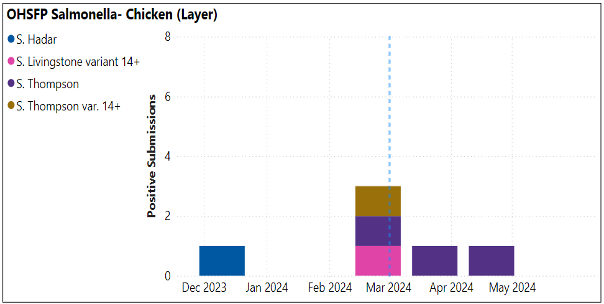
Layer-breeders
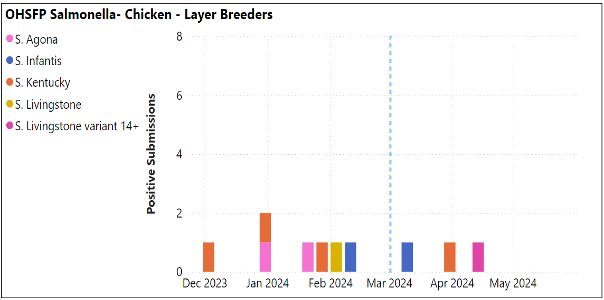
Turkeys
Practitioners
Multiple turkey flocks were detected with aMPV subtype B infection. The severity of the disease course was dictated by the existence of coinfections with E. coli, ORT or Mycoplasma, with E.coli being identified to be one the most common cause of increased mortality. The clinical signs were described as neurological and swollen heads were noted on the affected birds. Also, infected breeding flocks were experiencing egg production drop or egg shape abnormalities for up to 3 weeks followed by almost full production recovery. Antibiotic usage was implemented to control the secondary infections in the affected flocks.
Stable conditions: Other causes of early mortality (severe beak trimming), necrotic enteritis, enteritis, reovirus tenosynovitis and mycoplasmosis (M. gallisepticum).
Stable to increased: Late systemic bacterial infection (E.coli and Ornithobacterium), ORT, multi-drug resistant E. coli, aggression and cannibalism.
Stable to decreased: Fowl cholera, erysipelas, mycotic respiratory disease, coccidiosis, histomoniasis, round heart and salmonellosis.
Early systemic bacterial infection (<14 day old): Was mainly stable condition except one practitioner reporting decreased and another increased cases. E. coli and Streptococcus gallolyticus continues to be detected as the most common bacteria.
Frequency of conditions seen in the flocks:
Common, rare or not seen: Other causes of early mortality, ORT, multi-drug resistant E. coli, reovirus tenosynovitis, aggression and cannibalism.
Common or not seen: Late systemic bacterial infection.
Rare: Early systemic bacterial infection.
Rare or not seen: Erysipelas, mycotic respiratory disease, coccidiosis, histomoniasis, necrotic enteritis, enteritis and round heart.
Not seen: Fowl cholera.
AHL
New conditions: Avian metapneumovirus.
Sinusitis: E. coli and P. aeruginosa.
Similar number of cases (from previous quarter):
- Late systemic bacterial infection (>14 d old) – E. coli isolated in pure culture or in combination with S. gallolyticus. In addition, E. coli, E. cecorum and P. aeruginosa combined.
- Bacterial pneumonia – E. coli isolated in pure culture or in combination with C. perfringens. Sinusitis.
- Tibial dyschondroplasia.
Increased number of cases (from previous quarter):
- Early systemic bacterial infection (<14 day old) – E. coli and E. cecorum. One case of cellulitis, osteomyelitis (skull) and rhinitis.
- Other causes of early mortality (<14 d old) – Caustic injury (oral) and mycotic airsacculitis/pneumonia/encephalitis.
- Mycotic respiratory disease.
- Enteric disease.
- Coccidiosis (small intestine).
- Reovirus (PA 13-22342).
Decreased number of cases (from previous quarter): None.
No cases diagnosed this quarter:
- Fowl cholera (Pasteurella multocida).
- Erysipelas.
- ORT (Ornithobacterium rhinotracheale).
- Necrotic enteritis.
- Histomoniasis.
- Mycoplasma.
- Rickets.
- Condemnations.
- DOA.
Other diagnostic findings:
Tenosynovitis, bacterial osteomyelitis, bacterial dermatitis, bacterial omphalitis and ventriculitis.
Salmonellosis (clinical)/Salmonella isolation:
Practitioners: Reported stable to slightly decreased. S. Brandenburg, S. Hadar and S. Senftenberg were listed as the main isolates.
Animal Health Laboratory Salmonella Isolations: Turkey – Meat
- OHSFP – No Salmonella detections.
- Non-OHSFP: S. Uganda, S. Heidelberg and S. Muenchen isolated.
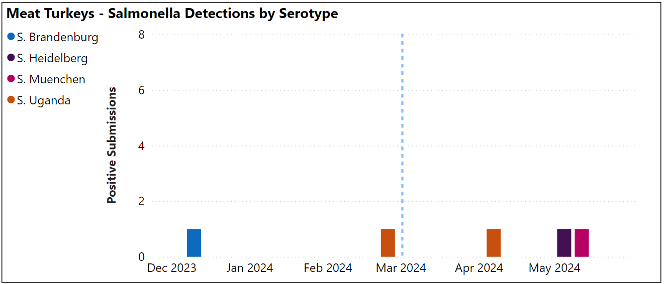
Animal Health Laboratory Salmonella Isolations: Turkey – breeders
- OHSFP – All environmental samples this quarter with fewer detections reported compared with the winter months.
- Non-OHSFP – S. Liverpool and S. Uganda reported on environmental samples.
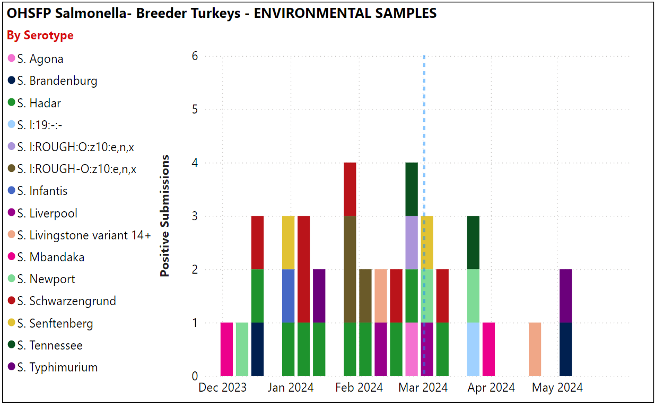
Provincial slaughter plants condemnations:
The top carcass postmortem conditions reported for March to May 2024 were airsacculitis, peritonitis and abscess.
Comparison of provincial condemnation conditions:
Jan-May 2023
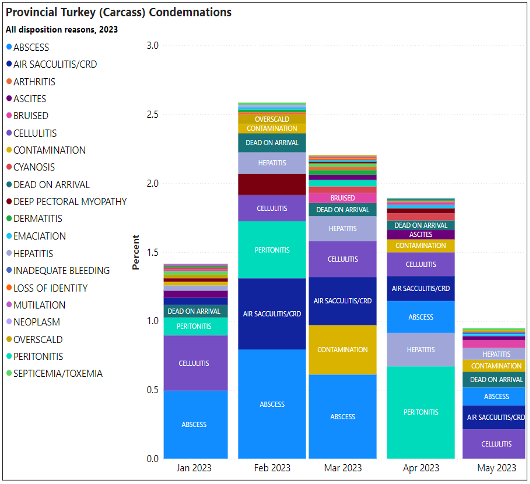
Jan-May 2024
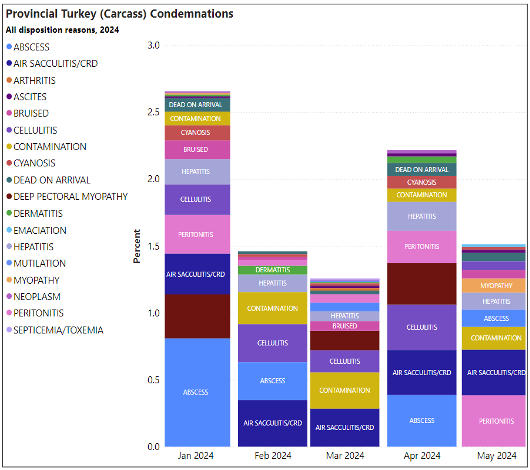
Number of turkeys slaughtered, Jan-Jul 2024.
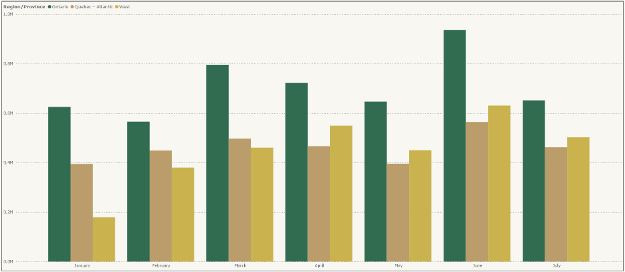
The top condemnation conditions for turkeys slaughtered in federal plants in Ontario from Jan-Jun 2024 were subcutaneous conditions, emaciation, and respiratory conditions (graph below).
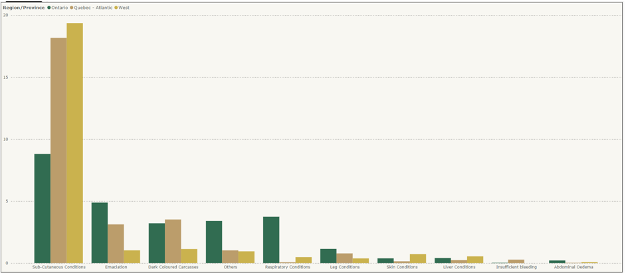
Small Flock
Chickens:
AHL: Diagnoses at AHL included mites (leg, external), intestinal parasitism (coccidiosis, heterakis, cestodes), Marek’s disease, neoplasia (adenocarcinoma), salpingitis, peritonitis, bacterial septicemia (E.coli), pneumonia (mycotic/E. coli, E. cecorum/G. anatis/S. hyicus), urate nephrosis/visceral urates, ascites, histomoniasis, MG/MS, egg bound/vaginitis/cloacitis, sinusitis (ORT), acid fast bacteria, emaciation, necrotic enteritis, encephalitis, and degenerative neuropathy/neuritis.
Practitioners: Reporting all conditions stable but with different frequency seen in the field as follows:
- Common: Ectoparasitism (lice, mites, scaly leg mites), peritonitis/salpingitis, pododermatitis, GI impaction, pneumonia/airsacculitis, endoparasitism and mycoplasma.
- Rare: Trauma and vent trauma, urate nephrosis/visceral gout/articular urate deposits, histomoniasis, Marek’s disease and other neoplasia, bacterial septicemia, toxins, histomoniasis, erysipelas and fatty liver haemorrhagic syndrome.
ILT: One case diagnosed in small flocks during this quarter (could not type).
Gamebird/Ratities:
AHL: One partridge case submitted this quarter (septicemia).
Practitioners: No information provided with the clinical impression for this quarter.
Waterfowl:
AHL: Two duck cases submitted this quarter.
1) Emaciation
2) Bone fracture, absent digits (both feet), absent feet (distal/mid metatarsus)
Practitioners: Reporting all conditions stable but with different frequency seen in the field as follows:
Common: Intestinal conditions, parasitism, pododermatitis and peritonitis.
Rare: Neoplasia, toxin, botulism, and bacterial septicemia.
Never seen: Mycotic pneumonia.
Turkey:
AHL: One case submitted this quarter (skin ulcers – both feet).
Practitioners: No information provided with the clinical impression this quarter.
Pigeons:
AHL: One case submitted this quarter (hepatopathy).
Practitioners: Reporting all conditions stable except decreased APMV-1 (paramyxovirus) and salmonellosis. The diseases/conditions frequency seen in the field is as follows:
Common: Trichomoniasis, intestinal parasitism (Capillaria), external parasitism, and bacterial infection.
Rare: AMPV-1, salmonellosis, chlamydiosis, pox, mycoplasmosis, fungal infection, traumatic, neoplasia or toxin.
Events and News
Poultry Industry Council events: https://www.poultryindustrycouncil.ca/events
Poultry Health Research Network information, events, and lectures can be accessed on the PHRN website: https://phrn.net/ or on the PHRN YouTube channel: https://www.youtube.com/user/PoultryHRN
Thank You!
We thank the following poultry veterinarians who completed the veterinary survey:
Dr. Elizabeth Black, Dr. Joanne Dias, Dr. Fernando Salgado-Bierman, Dr. Peter Gazdzinski, Dr. Shahbaz Haq, Dr. Elana Huong, Dr. Anastasia Novy, Dr. Mike Petrik, Dr. Joanne Rafuse, Dr. Ben Schlegel, Dr. Chanelle Taylor, Dr. Brenna Tuer, Dr. Alex Weisz, Dr. Jessalyn Walkey, and Small Flock Veterinarians.
